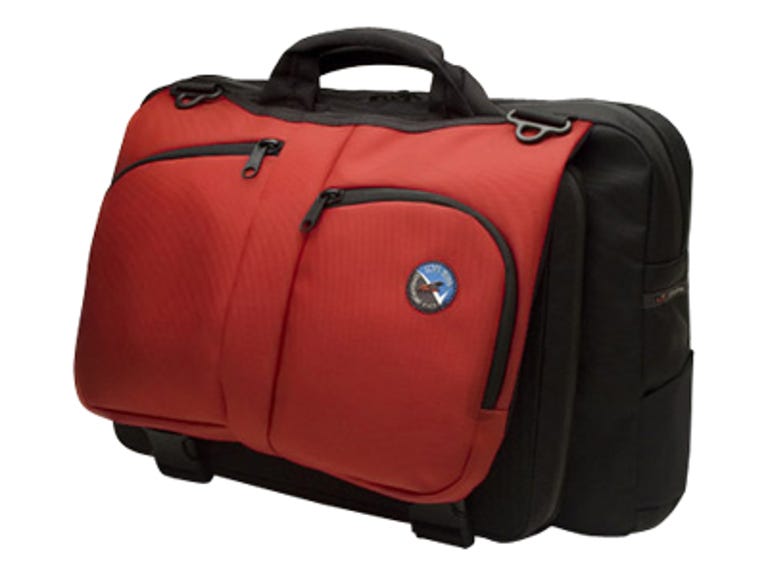 Why You Can Trust CNET
Why You Can Trust CNET Tom Bihn Checkpoint Flyer review: Tom Bihn Checkpoint Flyer
Tom Bihn Checkpoint Flyer
We're not the first publication to fall in love with Tom Bihn's Checkpoint Flyer briefcase. The costly laptop carrier is lightweight, well-thought-out, and extremely easy to use. Plus, it meets the TSA guidelines for bags that will let you zip through airport security without removing your laptop. Our greatest concern about the Checkpoint Flyer is its premium price; not every user can afford to spend $220 on a laptop bag. But like the best premium luggage, the bag's modular design and sturdy construction make it a long-term investment. If you travel frequently and the cost is within your means, we recommend the Checkpoint Flyer.
The Good
The Bad
The Bottom Line
The TSA's new laptop-bag guidelines suggest a butterfly, trifold, or sleeve-style case that keeps your laptop separate from other travel detritus so that a security screener can get a good look at it as it goes through the X-ray. The briefcase-style Checkpoint Flyer represents a variation on the trifold design. Its front panel attaches to the bottom of the bag via two large plastic buckles; you unlatch these buckles and lift up the front panel to reveal the laptop compartment, which unfolds downward. (These step-by-step pictures at ZDNet show exactly how it unfolds.)
The benefits of this design are threefold: First, the laptop is still rather protected by the bag's front flap. Second, unlike a messenger-style bag, the front panel does not have to be opened in order to reach the rest of the bag's contents. The only times you have to unclip the front panel are when you're going through a checkpoint or removing your laptop. And third, the laptop sleeve itself can be detached from the bag, letting you trim down and carry just your laptop; you can also easily swap in a larger or smaller sleeve, so you don't have to change bags if you buy a laptop in a different size.
We had a hearty skepticism about whether the bag could actually breeze through a checkpoint--after all, an individual TSA agent can still ask you to remove your laptop for any reason--but were pleasantly surprised when we cruised through the checkpoints at both ends of a recent trip. We were even more pleased that the bag had plenty of room for our 13-inch laptop, camera and other peripherals, cell phone, power cords, and notepad--basically everything we needed for an overnight business trip.
To accommodate all this stuff for travel, the Checkpoint Flyer incorporates plenty of pockets. Two large, curved pockets on the front panel keep your cell phone, paperback, and other frequently used items within easy reach; the larger of the two pockets includes a detachable key fob. Under the front panel and behind the laptop compartment, two 10-inch-wide horizontal zipper pockets keep cables, pens, or other small items in place. Inside the bag's roomy main compartment, two broad pockets keep power cables, peripherals, or (if you're using it as an overnight bag) clothing contained. If you need even more organization options, nearly every pocket on the Checkpoint Flyer incorporates a ring to attach one of the company's organizer pouches (sold separately); the company also sells inserts with extra pockets for accessories and files, though we found such an insert unnecessary.
On the outside of the Checkpoint Flyer are two side pockets for pens or a small cell phone. The back of the bag includes a narrow pocket to keep your boarding pass within easy reach. There's also a wider pocket for a newspaper or magazine; in a very thoughtful touch, the manufacturer equipped this pocket with a useful zip-open slot that lets you slip the bag over the handle of your rolling luggage. Given how much you can fit in the bag, this last feature will give your shoulder a much-needed break from carrying the bag.
The main color of the Checkpoint Flyer is black, but buyers can choose among black, gray, or red material for the front pouch. (Our review unit had a sporty red.) The interior of the main compartment features a gray fabric with a white grid, which makes it easier to locate items inside the bag. Made of ballistic nylon Cordura nylon, with splash-proof external zippers, the bag feels sturdily constructed and likely to last for years.
